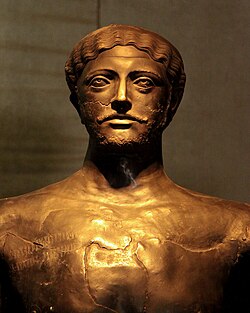Our website is made possible by displaying online advertisements to our visitors.
Please consider supporting us by disabling your ad blocker.
Qahtanite
| Banu Qahtan بنو قحطان Al 'Arab Al 'Ariba العرب العاربة | |
|---|---|
| Qahtanite, Children of Qahtan/Joktan | |
 A bronze statue of Dhamar Ali Yahbur II, a Himyarite king who probably reigned in the late 3rd or early 4th century AD. Displayed in the Sana'a National Museum | |
| Nisba | al-Qahtani (masculine) al-Qahtaniyyah (feminine) |
| Location | The southern region of the Arabian Peninsula, e.g. Yemen[1] |
| Descended from | Yarub bin Qahtan |
| Religion | Arabian mythology, Islam, Nestorian Christianity, Judaism, Aksumite polytheism, Nicene and Miaphysite Christianity |
Qahtanite (/ˈkɑːtənaɪt/; Arabic: قَحْطَانِي, romanized: Qaḥṭānī) refers to Arabs who originate from modern-day Yemen.[1][2] The term "Qahtan" is mentioned in multiple ancient Arabian inscriptions found in Yemen. Arab traditions believe that they are the original Arabs.[3][4][5][6]
In some Judeo-Christian-Islamic traditions such as Jubilees and some Jasherian tales the Qahtanite Arabs descend from Jokshan son of Abraham through Keturah and half brother of Ishmael son of Abraham through Hagar.
- ^ a b "Qaḥṭān". Britannica Online Encyclopedia. 2009.
- ^ O'Leary, De Lacy (2001). Arabia Before Muhammad. Psychology Press. p. 18. ISBN 978-0-41524-466-4.
Qahtan are divided into the two sub-groups of Himyar and Kahlan.
- ^ "Epigraph details: Gr 24". DASI: Digital Archive for the Study of Pre-Islamic Arabian Inscriptions. Retrieved 2022-03-11.
- ^ "Epigraph details: Ja 2360". DASI: Digital Archive for the Study of Pre-Islamic Arabian Inscriptions. Retrieved 2022-03-11.
- ^ "Epigraph details: DAI Barʾān 2000-1". DASI: Digital Archive for the Study of Pre-Islamic Arabian Inscriptions. Retrieved 2022-03-11.
- ^ "Epigraph details: Ja 635". DASI: Digital Archive for the Study of Pre-Islamic Arabian Inscriptions. Retrieved 2022-03-11.
Previous Page Next Page


